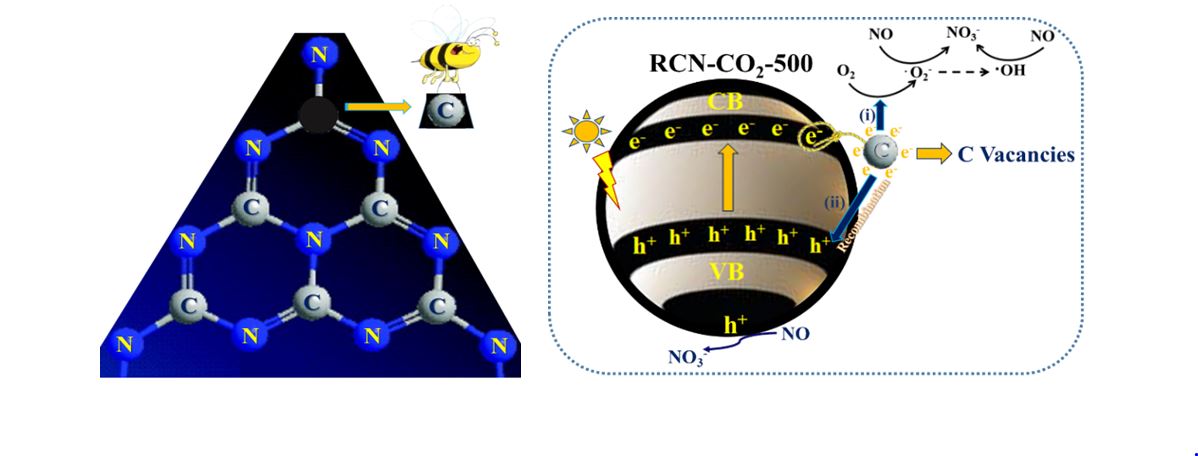Video Article Open Access
Surface Structure Tuning Induced Enhancement of Visible-Light-Driven g-C3N4 Photocatalyst for the Abatement of Nitric Oxides
Wingkei Ho*, Yuhan Li
Department of Science and Environmental Studies, The Education University of Hong Kong, Tai Po, N.T., Hong Kong, P.R. China
Vid. Proc. Adv. Mater., Volume 2, Article ID 2021-0183 (2021)
DOI: 10.5185/vpoam.2021.0183
Publication Date (Web): 13 Feb 2021
Copyright © IAAM
Graphical Abstract

Abstract
Surface defects or vacancies exert an important effect on the activity of photocatalysts. For example, the surface oxygen vacancy can enhance the photocatalytic activity of TiO2 and that Ti3+ defects are not conducive to the enhancement of photocatalytic activity. Surface defect structure also affects the adsorption of photocatalysts. It was reported that the selectivity of NO removal reaction can be changed by creating a large concentration of oxygen vacancies in TiO2 nanoparticles through thermal reduction in a reducing atmosphere. Nitrogen vacancies of g-C3N4 have also been extensively investigated and applied in photocatalysis and catalysis. Compared with the frequently studied nitrogen vacancies of g-C3N4, engineering carbon vacancies in g-C3N4 is still of great significance challenge. Herein, our research investigated the performance of photocatalyst, g-C3N4 with carbon vacancies in oxidizing NO and NO2 to HNO3 under visible light irradiation. It was found that carbon vacancies increased the conductivity, and remarkably enhanced photocatalytic oxidation NO and NO2 activities. Base on this finding, further study was carried out on how other surface vacancies can engineer the structure characteristics and physiochemical properties of photocatalyst. It another study, the positive influence of graphene on the structure and visible photocatalytic activity of Zn2SnO4 in oxidation of NO was systematically investigated based on the fact that graphene has the property of high electronic conductivity for transporting and storing electrons. We found that the presence of graphene not only induces the formation of SnO2, but also introduces Sn vacancy, which can trigger the visible light photocatalytic activity.
Keywords
Surface vacancies, g-C3N4, NO and NO2 removal, photocatalysis.
Acknowledgement
GRF/ECS by The Research Grants Council (RGC) by HKSAR.
References
- Li, Y.; Wu, X.; Ho, W. K.; Lv, K.; Li, Q.; Li, M.; Lee, S.S.; “Graphene-induced formation of visible-light-responsive SnO2-Zn2SnO4 Z-scheme photocatalyst with surface vacancy for the enhanced photoreactivity towards NO and Acetone”, Chemical Engineering Journal, 2018, 336, 200-210.
- Li Y., Ho W. K., Lv K., Zhu B., Lee S.C., “Carbon vacancy-induced enhancement of the visible light-driven photocatalytic oxidation of NO over g-C3N4 nanosheets”, Applied Surface Science, 2018, 430, 380-389.
- Li, Y.; Sun, Y.; Ho, W. K.; Zhang, Y.; Huang, H.; Cai, W.; Dong, F. “Highly enhanced visible-light photocatalytic NOx purification and conversion pathway on self-structurally modified g-C3N4 nanosheets” Science Bulletin, 2018, 63 (10), 609-620.
Biography
Ho Wing Kei, Keith is the Associate Professor and deputy Head of the Department of Science and Environmental Studies at The Education University of Hong Kong. Dr. Ho received his BSc and PhD in The Chinese University of Hong Kong, and was awarded the post-doctoral fellowships in Hong Kong and Canada. Dr. Ho has been working in the areas of air pollution control, design of photocatalytic materials and nanotechnology in air purification for 15 years. He achieved research funding in different projects over ten million dollars as Principle Investigator in the past eight years. He has published 130 journals which are totally cited 18000 times and his h-index = 68. More than ten patents in US, Europe. China and Hong Kong have been granted from Dr. Ho’s research in the air purification and disinfection technology. Dr. Ho was the Awardee of the Research Grants Council Early Career Award from the Hong Kong government and the President’s Award for Outstanding Performance in Research from his university. Dr. Ho was named in the list of “Highly Cited Researchers 2018 and 2019” among the world’s top researchers in Highly Cited Researchers (HCR) from Clarivate Analytics.
Video Proceedings of Advanced Materials

Upcoming Congress



